Revealing Urban Carbon Dioxide (CO2) Emission Characteristics and Influencing Mechanisms from the Perspective of Commuting
Abstract
1. Introduction
2. Materials and Methodology
2.1. Study Area
2.2. Methodology
2.2.1. Calculation of Commuting-Related CO2 Emissions
2.2.1.1. Calculation of Commuting Distance for Each Mode of Transport
2.2.1.2. Calculation of CO2 Emissions
2.2.1.3. Calculation of CO2 Emissions Factors for each Travel Mode
2.2.2. Commuting-Related CO2 Emission Model Based on Tobit Models
2.3. Data Sources
3. Results and Discussion
3.1. Annual Change of Commuting-Related CO2 Emissions
3.2. Characteristics of CO2 Emissions due to Commuting by Ring Roads in Beijing
3.3. Influencing Mechanisms for Commuting-Related CO2 Emissions
4. Conclusions
Author Contributions
Funding
Acknowledgments
Conflicts of Interest
References
- World Meteorological Organization (WMO). 2013 WMO Greenhouse Gas Bulletin; World Meteorological Organization: Geneva, Switzerland, 2014. [Google Scholar]
- Centre for International Climate and Environmental Research—Oslo (CICERO). Carbon Emissions from Transport Has Been Rapidly Increasing, 2008. Xinhua Net. Available online: http://news.xinhuanet.com/newscenter/2008-01/11/content_7402098.htm.2008.01.11 (accessed on 13 January 2019).
- Cervero, R.; Day, J. Residential Relocation and Commuting Behavior in Shanghai, China: The Case for Transit Oriented Development; UC Berkeley: UC Berkeley Center for Future Urban Transport: A Volvo Center of Excellence: Berkeley, CA, USA, 2008; Available online: http://www.escholarship.org/uc/item/0dk1s0q5.2008.04.01 (accessed on 13 January 2019).
- Pan, H.; Shen, Q.; Zhang, M. Influence of urban form on travel behaviour in four neighbourhoods of Shanghai. Urban Stud. 2009, 46, 275–294. [Google Scholar] [CrossRef]
- Wang, D.; Chai, Y. The jobs-housing relationship and commuting in Beijing, China: The legacy of Danwei. J. Transp. Geogr. 2009, 17, 30–38. [Google Scholar] [CrossRef]
- Liu, Z.; Ma, J.; Chai, Y. Neighborhood-scale urban form, travel behavior, and CO2 emissions in Beijing: Implications for low-carbon urban planning. Urban Geogr. 2017, 38, 381–400. [Google Scholar] [CrossRef]
- Beijing Municipal Commission of Transport (BMCT); Beijing Transport Institute (BTI). Fifth Comprehensive Survey on Urban Traffic in Beijing; Beijing Municipal Commission of Transport: Beijing, China, 2016. [Google Scholar]
- Chapman, L. Transport and climate change: A review. J. Transp. Geogr. 2007, 15, 354–367. [Google Scholar] [CrossRef]
- Grazi, F.; van den Bergh, J.C. Spatial organization, transport, and climate change: Comparing instruments of spatial planning and policy. Ecol. Econ. 2008, 67, 630–639. [Google Scholar] [CrossRef]
- Hankey, S.; Marshall, J.D. Impacts of urban form on future US passenger-vehicle greenhouse gas emissions. Energy Policy 2010, 38, 4880–4887. [Google Scholar] [CrossRef]
- Jo, J.H.; Golden, J.S.; Shin, S.W. Incorporating built environment factors into climate change mitigation strategies for Seoul, South Korea: A sustainable urban systems framework. Habitat Intl. 2009, 33, 267–275. [Google Scholar] [CrossRef]
- Yang, W.; Li, T.; Cao, X. Examining the impacts of socio-economic factors, urban form and transportation development on CO2 emissions from transportation in China: A panel data analysis of China’s provinces. Habitat Int. 2015, 49, 212–220. [Google Scholar] [CrossRef]
- Xiao, Z.; Lenzer, J.H., Jr.; Chai, Y. Examining the uneven distribution of household travel carbon emissions within and across neighborhoods: The case of Beijing. J. Regional. Sci. 2017, 57, 487–506. [Google Scholar] [CrossRef]
- Wang, Y.; Yang, L.; Han, S.; Li, C.; Ramachandra, T.V. Urban CO2 emissions in Xi’an and Bangalore by commuters: Implications for controlling urban transportation carbon dioxide emissions in developing countries. Mitig. Adapt. Strateg. Glob. 2017, 22, 993–1019. [Google Scholar] [CrossRef]
- Feng, K.; Hubacek, K.; Guan, D. Lifestyles, technology and CO2 emissions in China: A regional comparative analysis. Ecol. Econ. 2009, 69, 145–154. [Google Scholar] [CrossRef]
- Wei, Y.M.; Liu, L.C.; Fan, Y.; Wu, G. The impact of lifestyle on energy use and CO2 emission: An empirical analysis of China’s residents. Energy Policy 2007, 35, 247–257. [Google Scholar] [CrossRef]
- Dietz, T.; Gardner, G.T.; Gilligan, J.; Stern, P.C.; Vandenbergh, M.P. Household actions can provide a behavioral wedge to rapidly reduce US carbon emissions. Proc. Natl. Acad. Sci. USA 2009, 106, 18452–18456. [Google Scholar] [CrossRef]
- Brand, C.; Tran, M.; Anable, J. The UK transport carbon model: An integrated life cycle approach to explore low carbon futures. Energy Policy 2012, 41, 107–124. [Google Scholar] [CrossRef]
- Pongthanaisawan, J.; Sorapipatana, C. Greenhouse gas emissions from Thailand’s transport sector: Trends and mitigation options. Appl. Energy 2013, 101, 288–298. [Google Scholar] [CrossRef]
- Boussauw, K.; Witlox, F. Introducing a commute-energy performance index for Flanders. Transp. Res. A-Policy Pract. 2009, 43, 580–591. [Google Scholar] [CrossRef]
- Baiocchi, G.; Minx, J.; Hubacek, K. The impact of social factors and consumer behavior on carbon dioxide emissions in the United Kingdom. J. Ind. Ecol. 2010, 14, 50–72. [Google Scholar] [CrossRef]
- Büchs, M.; Schnepf, S.V. Who emits most? Associations between socio-economic factors and UK households’ home energy, transport, indirect and total CO2 emissions. Ecol. Econ. 2013, 90, 114–123. [Google Scholar] [CrossRef]
- Brand, C.; Boardman, B. Taming of the few—The unequal distribution of greenhouse gas emissions from personal travel in the UK. Energy Policy 2008, 36, 224–238. [Google Scholar] [CrossRef]
- Ko, J.; Park, D.; Lim, H.; Hwang, I.C. Who produces the most CO2 emissions for trips in the Seoul metropolis area? Transp. Res. Part D Transp. Environ. 2011, 16, 358–364. [Google Scholar] [CrossRef]
- Brand, C.; Goodman, A.; Rutter, H.; Song, Y.; Ogilvie, D. Associations of individual, household and environmental characteristics with carbon dioxide emissions from motorised passenger travel. Appl. Energy 2013, 104, 158–169. [Google Scholar] [CrossRef]
- Sun, X.; Wilmot, C.; Kasturi, T. Household travel, household characteristics, and land use: An empirical study from the 1994 Portland activity-based travel survey. Transp. Res. Rec. 1998, 1617, 10–17. [Google Scholar] [CrossRef]
- Brand, C.; Preston, J.M. ‘60-20 emission’—The unequal distribution of greenhouse gas emissions from personal, non-business travel in the UK. Transp. Policy 2010, 17, 9–19. [Google Scholar] [CrossRef]
- Susilo, Y.; Stead, D. Individual carbon dioxide emissions and potential for reduction in the Netherlands and the United Kingdom. Transp. Res. Rec. 2009, 2139, 142–152. [Google Scholar] [CrossRef]
- Yang, L.; Wang, Y.; Han, S.; Liu, Y. Urban transport carbon dioxide (CO2) emissions by commuters in rapidly developing Cities: The comparative study of Beijing and Xi’an in China. Transp. Res. Part D Transp. Environ. 2017. [Google Scholar] [CrossRef]
- Beijing Municipal Bureau of Statistics (BMBS). Beijing Statistical Yearbook; Beijing Municipal Bureau of Statistics: Beijing, China, 2006–2016. Available online: http://tjj.beijing.gov.cn/nj/main/2016-tjnj/zk/indexch.htm.2016.11.04 (accessed on 13 January 2019).
- Grazi, F.; van den Bergh, J.C.; van Ommeren, J.N. An empirical analysis of urban form, transport, and global warming. Energy J. Int. Assoc. Energy Econ. 2008, 29, 97–122. [Google Scholar] [CrossRef]
- Loo, B.P.; Li, L. Carbon dioxide emissions from passenger transport in China since 1949: Implications for developing sustainable transport. Energy Policy 2012, 50, 464–476. [Google Scholar] [CrossRef]
- Stead, D. Relationships between transport emissions and travel patterns in Britain. Transp. Policy 1999, 6, 247–258. [Google Scholar] [CrossRef]
- Wang, H.H.; Yu, L.Q.; Zeng, W.H. Potential of reducing carbon emission from urban transport based on adjustments to jobs-housing separation in Beijing. China Popul. Resour. Environ. 2018, 28, 41–51. (In Chinese) [Google Scholar]
- Intergovernmental Panel on Climate Change (IPCC). IPCC Guidelines for National Greenhouse Gas Inventories; IPCC: Geneva, Switzerland, 2006. [Google Scholar]
- Wooldridge, J. Econometric Analysis of Cross Section and Panel Data; MIT Press: Cambridge, MA, USA, 2002. [Google Scholar]
- Becken, S.; Schiff, A. Distance models for New Zealand international tourists and the role of transport prices. J. Travel Res. 2011, 50, 303–320. [Google Scholar] [CrossRef]
- Meyer, M.; Miller, E.J. Urban Transport Planning: A Decision-Oriented Approach; McGraw-Hill: Singapore, 2001; pp. 631–633. [Google Scholar]
- Rasouli, S.; Timmermans, H. Uncertainty in travel demand forecasting models: Literature review and research agenda. Transp. Lett. 2012, 4, 55–73. [Google Scholar] [CrossRef]
- Petrik, O.; Moura, F.; Silva, J.D.A.E. Measuring uncertainty in discrete choice travel demand forecasting models. Transp. Plan. Technol. 2016, 39, 218–237. [Google Scholar] [CrossRef]
- Efron, B.; Tibshirani, R.J. An Introduction to the Bootstrap; CRC Press: Boca Raton, FL, USA, 1993. [Google Scholar]
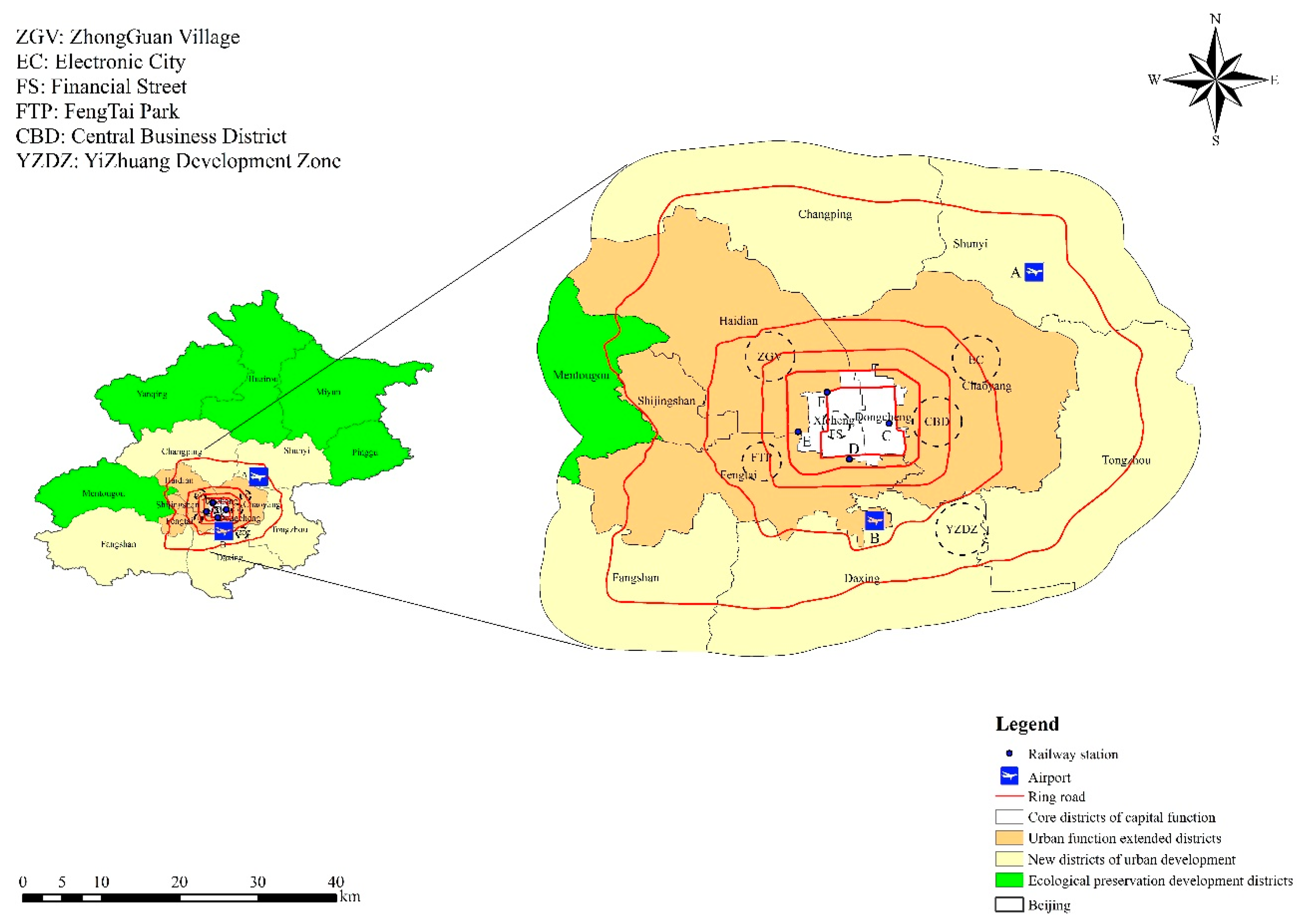
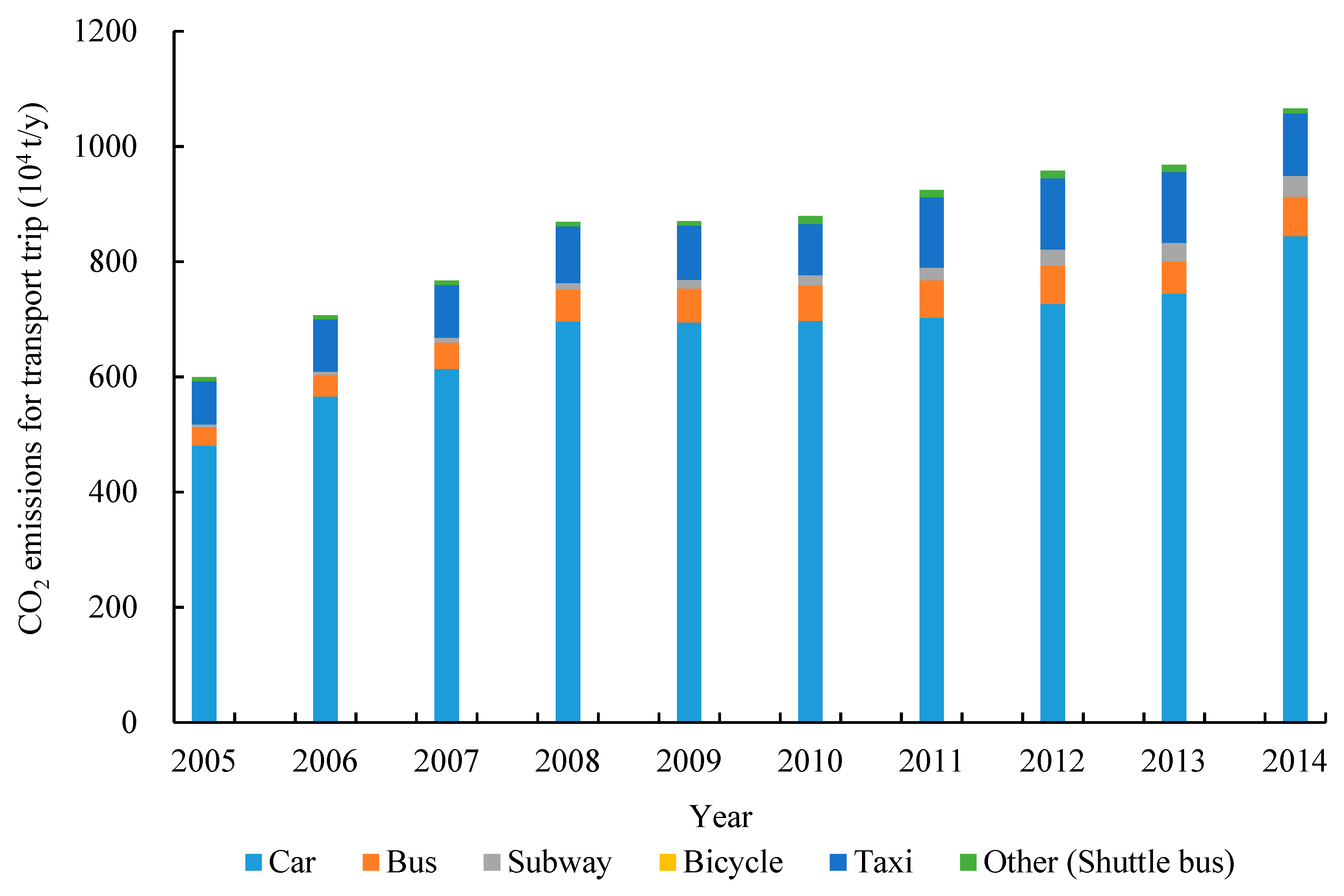
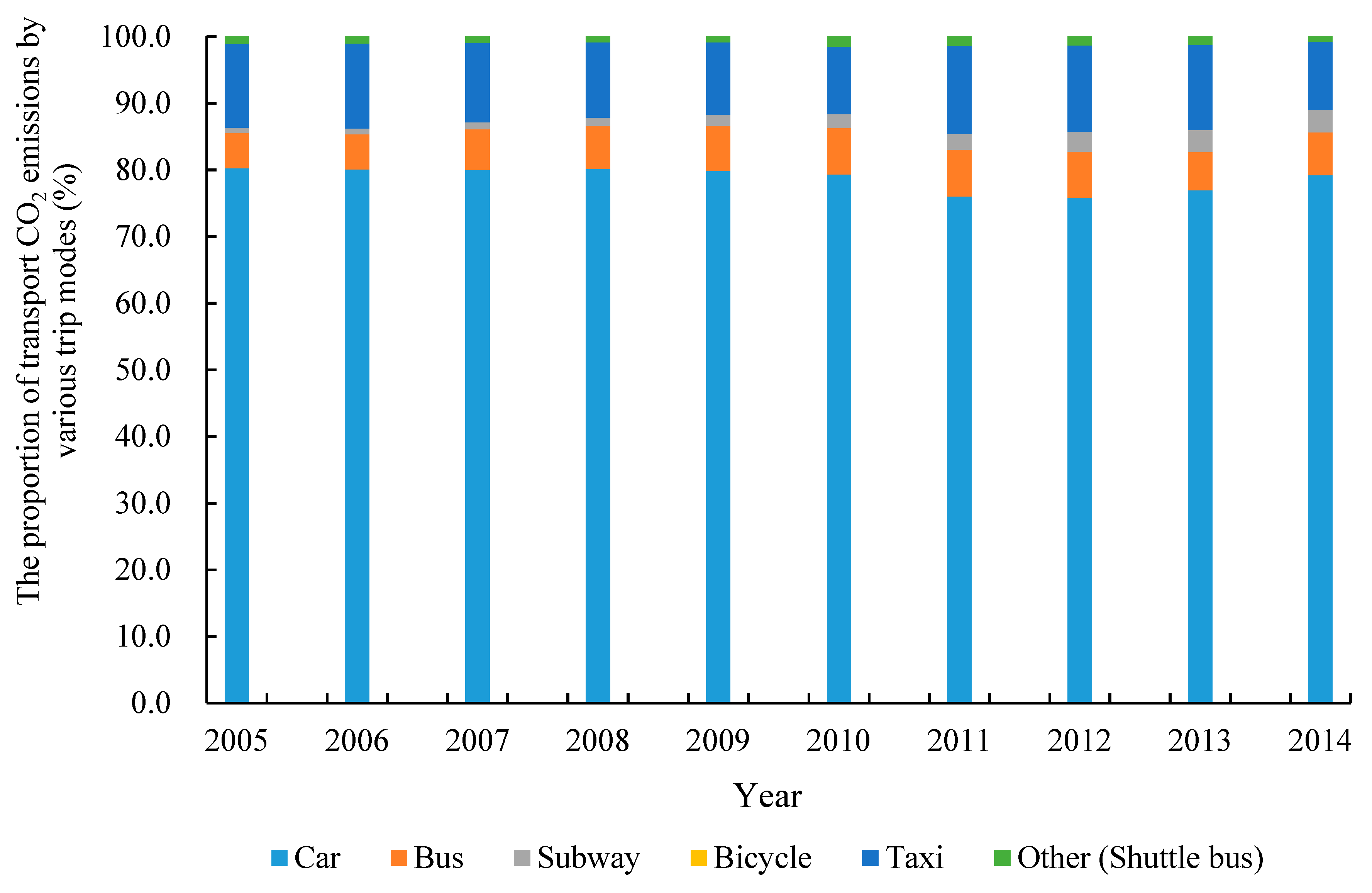
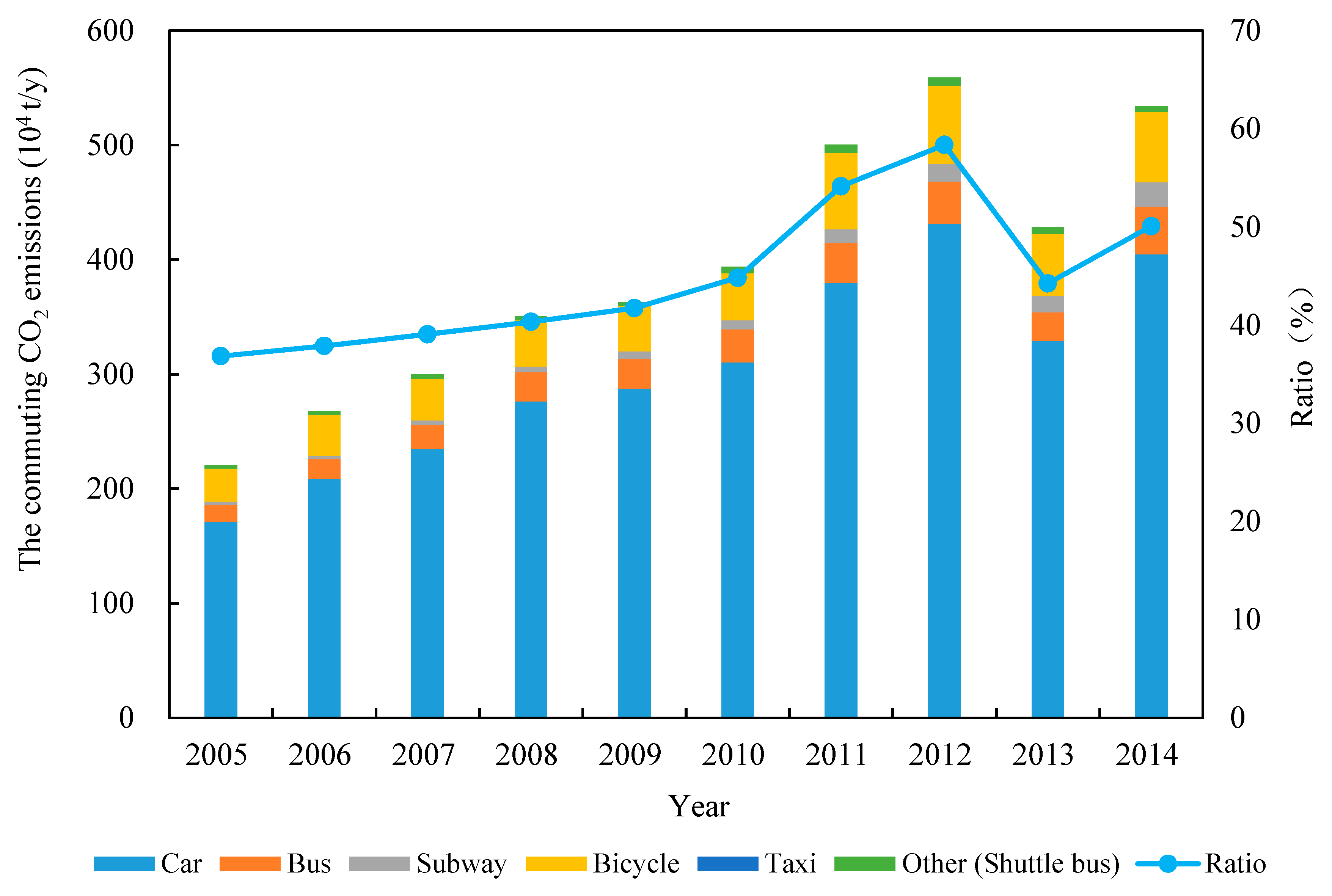


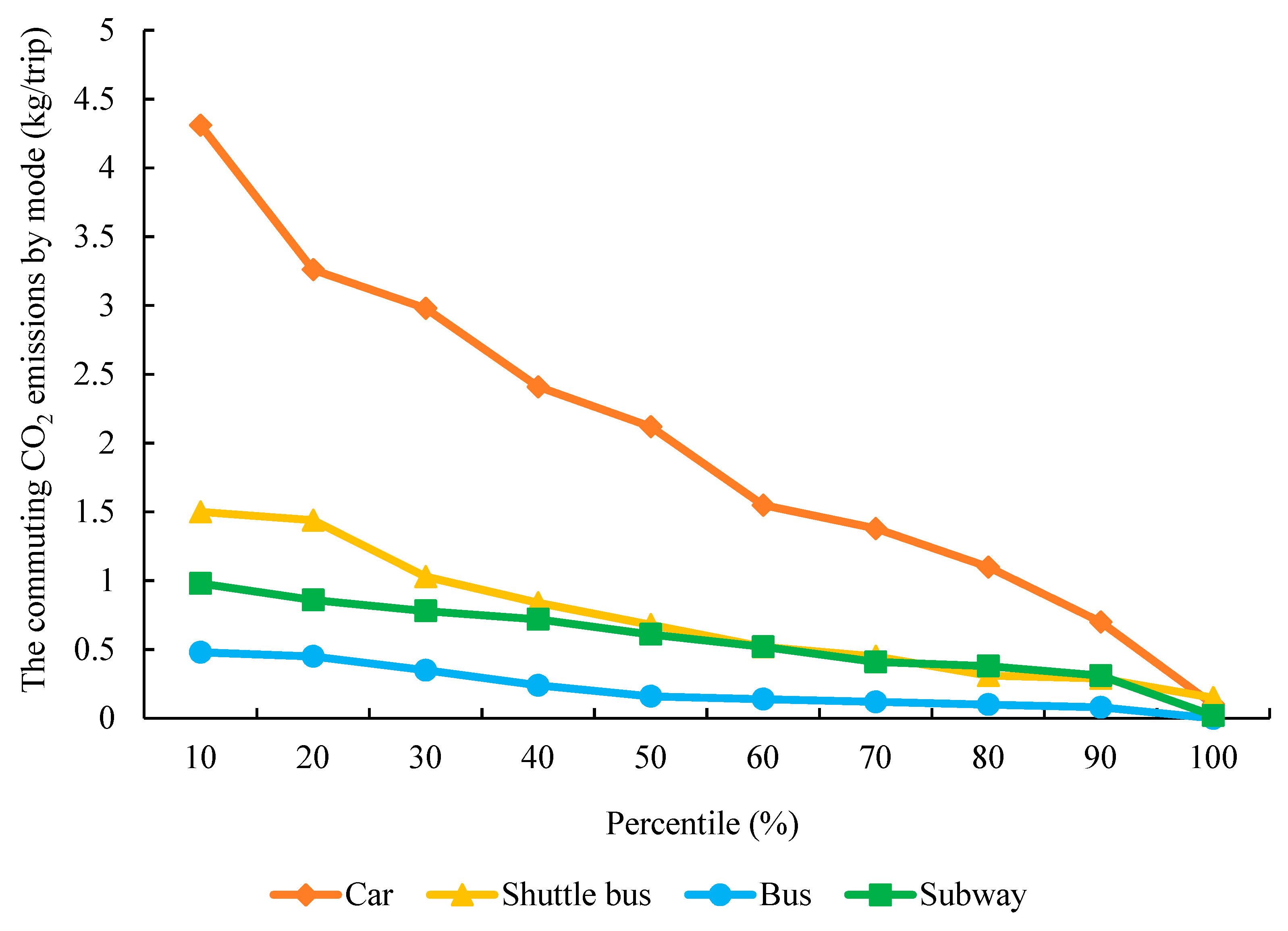
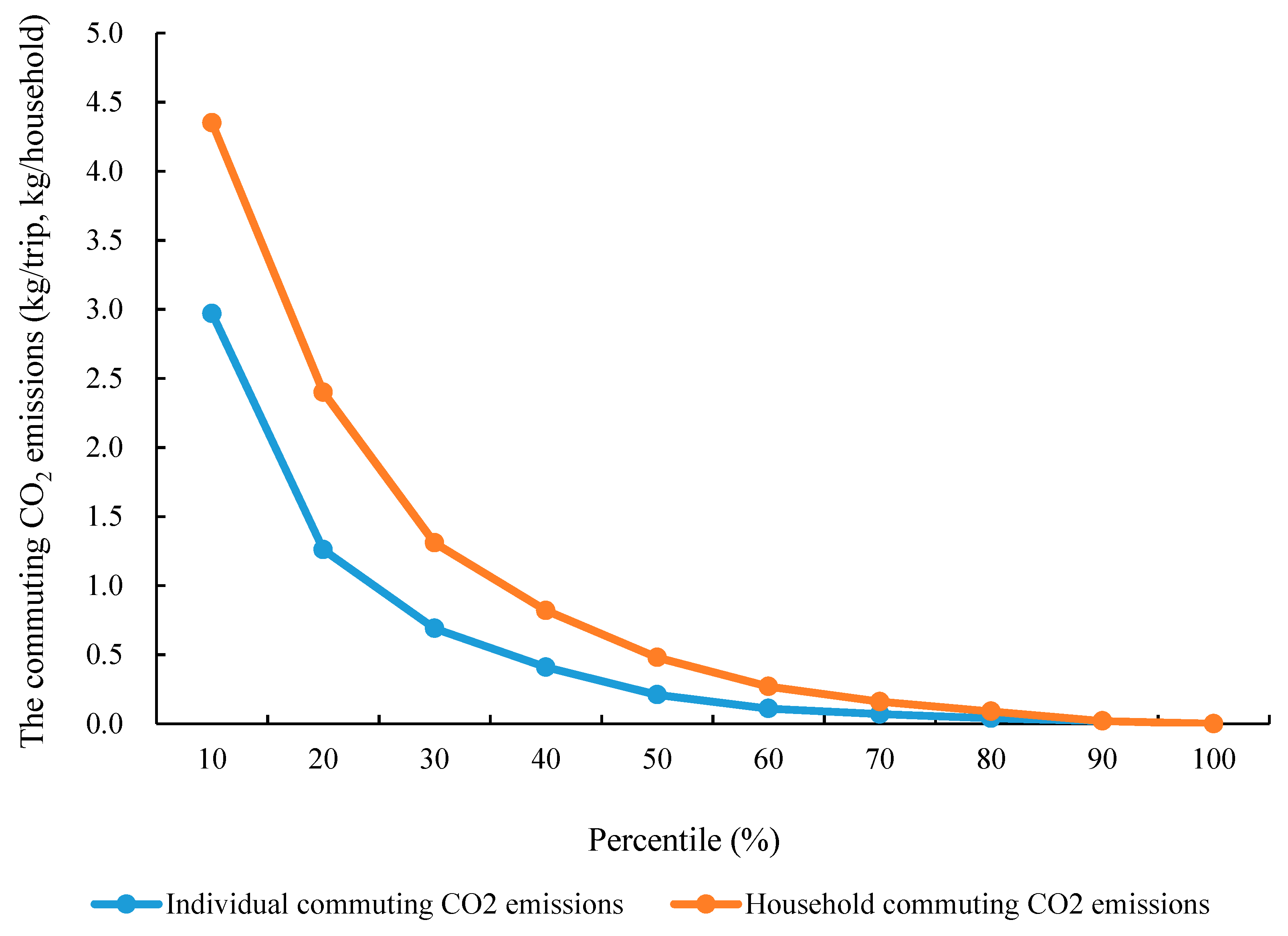
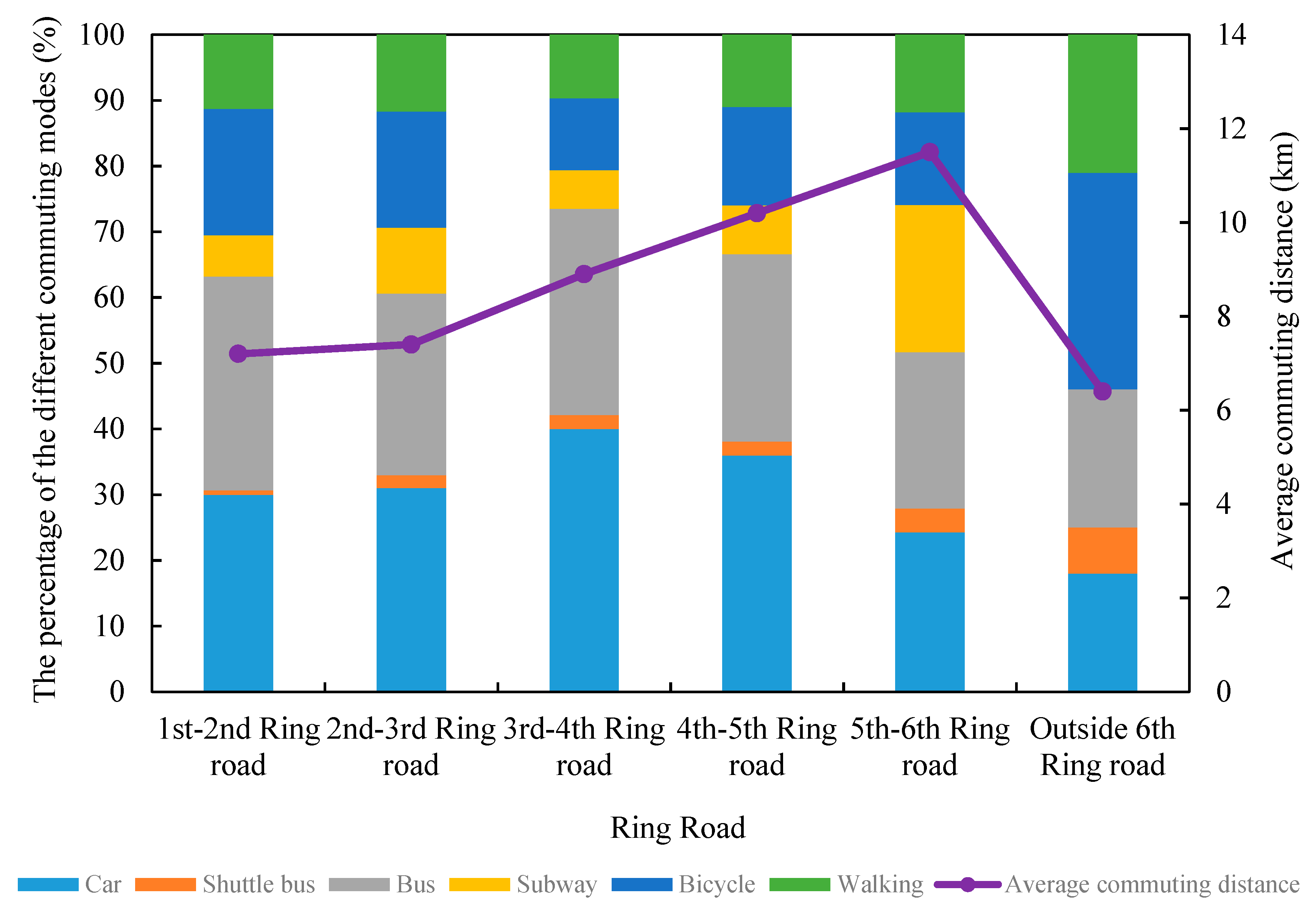
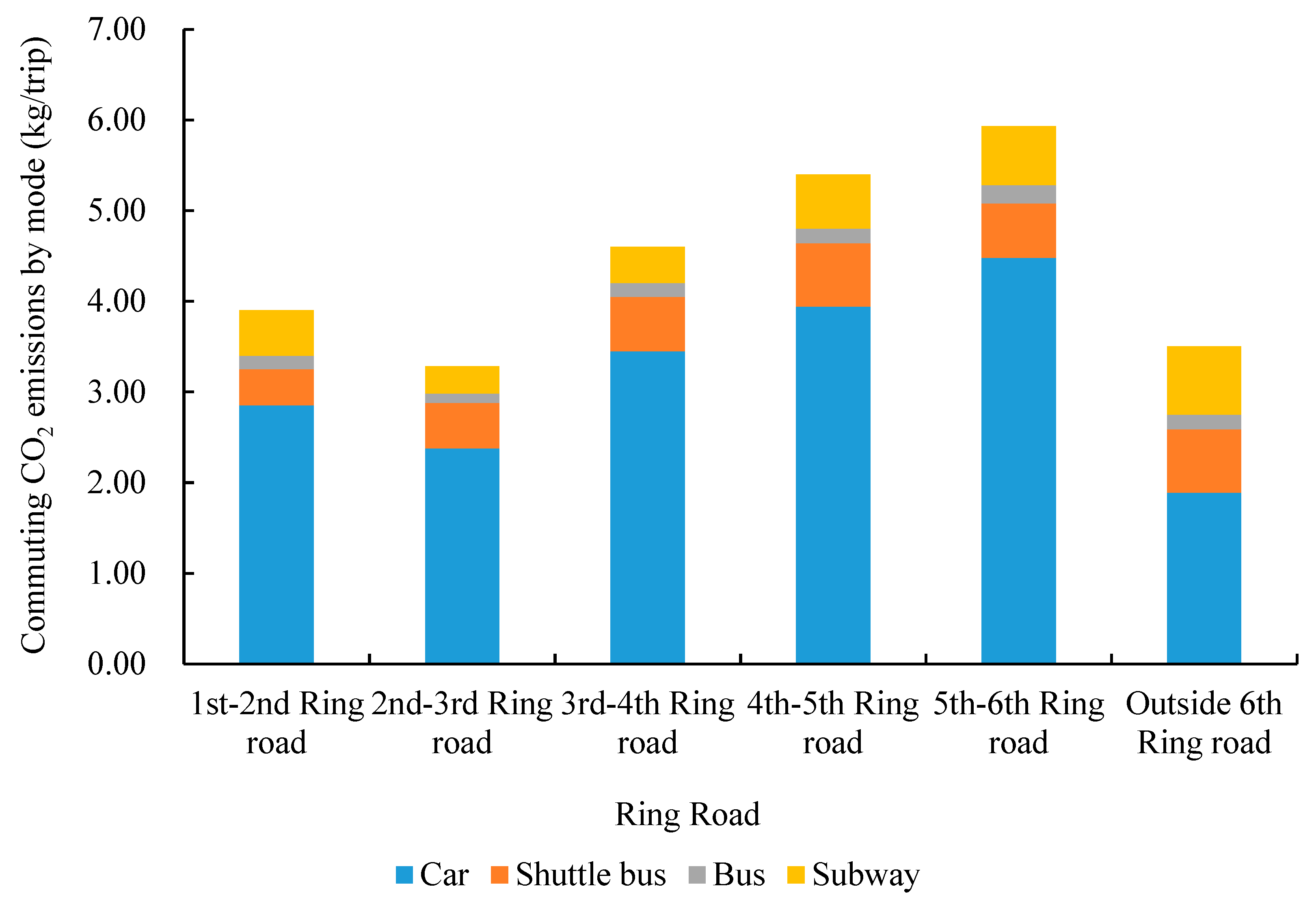
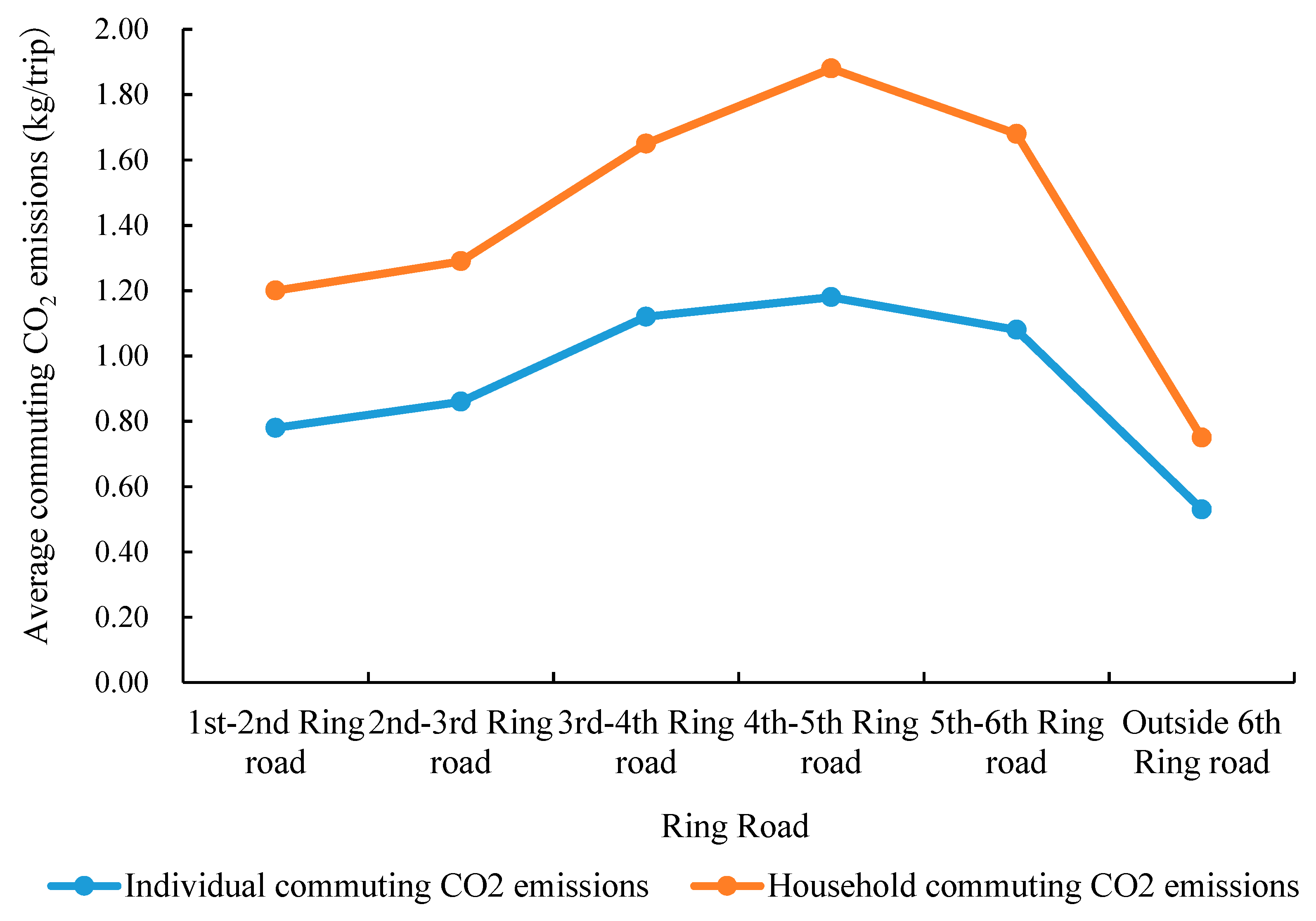
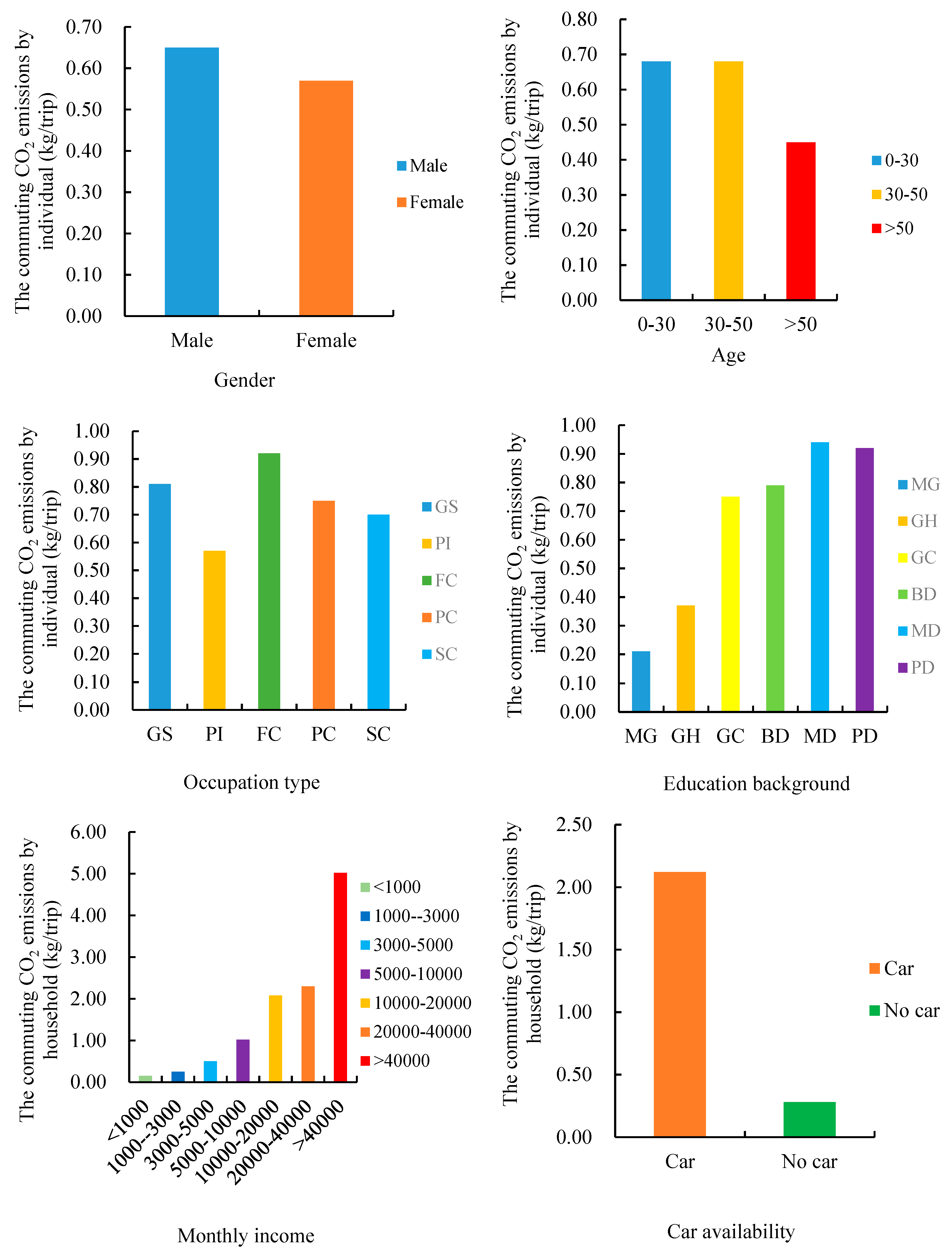
| Travel Mode | Fuel Consumption per km/L·km−1 | Fuel Density/kg·L−1 | Energy Calorific Value/TJ·kg−1 | CO2 Emissions Factors of Energy/kg·TJ−1 | Passenger Loadings | CO2 Emission Factor/kg·(people·km)−1 |
|---|---|---|---|---|---|---|
| Car | 0.088 | 0.725 | 0.0000443 | 69,300 | 1.1 | 0.1781 |
| Bus | 0.4 | 0.835 | 0.000043 | 74,100 | 50 | 0.0213 |
| Subway | 1.27 | / | 0.0000258 | 94,600 | 340 | 0.0091 |
| Taxi | 0.088 | 0.725 | 0.0000443 | 69,300 | 1.1 | 0.1781 |
| Shuttle bus | 0.4 | 0.835 | 0.000043 | 74,100 | 40 | 0.0266 |
| Non-motorized transport | 0 | 0 | 0 | 0 | 1 | 0 |
| - | Levels | N | (%) | - | Levels | N | (%) |
|---|---|---|---|---|---|---|---|
| Age | <30 years old | 671 | 36.5 | Household traffic vehicles | Car availability | 439 | 40.1 |
| 30–50 years old | 1058 | 57.7 | Household income (CNY/monthly) | <1000 | 17 | 1.4 | |
| >50 years old | 106 | 5.8 | 1000–3000 | 161 | 13.7 | ||
| Occupation type | GS | 171 | 9.4 | 3000-5000 | 238 | 20.2 | |
| PI | 532 | 29.3 | 5000–10,000 | 442 | 37.5 | ||
| FC | 101 | 5.5 | 10,000–20,000 | 279 | 23.7 | ||
| PC | 593 | 32.7 | 20,000–40,000 | 37 | 3.1 | ||
| SC | 335 | 18.5 | >40,000 | 5 | 0.4 | ||
| Others | 83 | 4.6 | Household location by Ring Roads | Inside the 1st Ring Road | 0 | 0 | |
| Educational background | MG | 119 | 6.5 | Inside the 2nd Ring Road | 93 | 8.5 | |
| GH | 363 | 19.8 | 2nd–3rd Ring Road | 202 | 18.4 | ||
| GC | 374 | 20.4 | 3rd–4th Ring Road | 194 | 17.7 | ||
| BD | 772 | 42.1 | 4th–5th Ring Road | 143 | 13 | ||
| MD | 179 | 9.7 | 5th–6th Ring Road | 255 | 23.2 | ||
| PD | 28 | 1.5 | Outside the 6th Ring Road | 211 | 19.2 |
| Independent Variables | Individual Models (kg/trip) | Household Models (kg/household trips) | ||
|---|---|---|---|---|
| Parameter Values | Significance Level | Parameter Values | Significance Level | |
| Car Availability (X1) | 1.113 | 0.000 | 1.565 | 0.000 |
| Household Location by Ring Roads | ||||
| Inside the 1st Ring Road (X2) | ||||
| Inside the 2nd Ring Road (X3) | −0.167 | 0.058 | ||
| 2nd–3rd Ring Road (X4) | 0.207 | 0.173 | ||
| 3rd–4th Ring Road (X5) | 0.215 | 0.001 | 0.496 | 0.000 |
| 4th–5th Ring Road (X6) | 0.226 | 0.008 | 0.693 | 0.000 |
| 5th–6th Ring Road (X7) | 0.271 | 0.000 | 0.802 | 0.000 |
| Outside the 6th Ring Road (X8) | ||||
| Occupation Type of Commuter | ||||
| GS (X9) | −0.189 | 0.079 | ||
| PI (X10) | −0.457 | 0.000 | ||
| FC (X11) | 0.159 | 0.132 | ||
| PC (X12) | ||||
| SC (X13) | ||||
| Others (X14) | ||||
| Household Monthly Income | ||||
| <1000 CNY (X15) | ||||
| 1000–3000 CNY (X16) | −0.935 | 0.000 | ||
| 3000–5000 CNY (X17) | −0.712 | 0.000 | ||
| 5000–10,000 CNY (X18) | −0.291 | 0.003 | ||
| 10,000–20,000 CNY (X19) | 0.235 | 0.064 | ||
| 20,000–40,000 CNY (X20) | ||||
| >40,000 CNY (X21) | 3.485 | 0.000 | ||
| F | 64.9 | 55.46 | ||
| Prob > F | 0 | 0 | ||
| Log pseudolikelihood | −2406.43 | −1635.68 | ||
| Observations | 1690 | 1012 | ||
| Independent Variables | Individual Models (kg/trip) | Household Models (kg/household trips) | ||
|---|---|---|---|---|
| Parameter Values | Standard Errors | Parameter Values | Standard Errors | |
| Car Availability (X1) | 1.113 | 0.047 | 1.565 | 0.132 |
| Household Location by Ring Roads | ||||
| Inside the 1st Ring Road (X2) | ||||
| Inside the 2nd Ring Road (X3) | −0.168 | 0.091 | ||
| 2nd–3rd Ring Road (X4) | 0.207 | 0.126 | ||
| 3rd–4th Ring Road (X5) | 0.215 | 0.083 | 0.496 | 0.163 |
| 4th–5th Ring Road (X6) | 0.226 | 0.096 | 0.693 | 0.191 |
| 5th–6th Ring Road (X7) | 0.271 | 0.076 | 0.802 | 0.159 |
| Outside the 6th Ring Road (X8) | ||||
| Occupation Type of Commuter | ||||
| GS (X9) | −0.189 | 0.143 | ||
| PI (X10) | −0.457 | 0.069 | ||
| FC (X11) | 0.159 | 0.129 | ||
| PC (X12) | ||||
| SC (X13) | ||||
| Others (X14) | ||||
| Household Monthly Income | ||||
| <1000 CNY (X15) | ||||
| 1000–3000 CNY (X16) | −0.936 | 0.151 | ||
| 3000–5000 CNY (X17) | −0.713 | 0.152 | ||
| 5000–10,000 CNY (X18) | −0.291 | 0.131 | ||
| 10,000–20,000 CNY (X19) | 0.235 | 0.172 | ||
| 20,000–40,000 CNY (X20) | ||||
| >40,000 CNY (X21) | 3.485 | 1.023 | ||
| Wald | 573.15 | 615.32 | ||
| Prob > | 0 | 0 | ||
| Log Pseudolikelihood | −2408.63 | −1635.68 | ||
| Observations | 1690 | 1012 | ||
© 2019 by the authors. Licensee MDPI, Basel, Switzerland. This article is an open access article distributed under the terms and conditions of the Creative Commons Attribution (CC BY) license (http://creativecommons.org/licenses/by/4.0/).
Share and Cite
Wang, H.; Zeng, W. Revealing Urban Carbon Dioxide (CO2) Emission Characteristics and Influencing Mechanisms from the Perspective of Commuting. Sustainability 2019, 11, 385. https://doi.org/10.3390/su11020385
Wang H, Zeng W. Revealing Urban Carbon Dioxide (CO2) Emission Characteristics and Influencing Mechanisms from the Perspective of Commuting. Sustainability. 2019; 11(2):385. https://doi.org/10.3390/su11020385
Chicago/Turabian StyleWang, Huihui, and Weihua Zeng. 2019. "Revealing Urban Carbon Dioxide (CO2) Emission Characteristics and Influencing Mechanisms from the Perspective of Commuting" Sustainability 11, no. 2: 385. https://doi.org/10.3390/su11020385
APA StyleWang, H., & Zeng, W. (2019). Revealing Urban Carbon Dioxide (CO2) Emission Characteristics and Influencing Mechanisms from the Perspective of Commuting. Sustainability, 11(2), 385. https://doi.org/10.3390/su11020385




